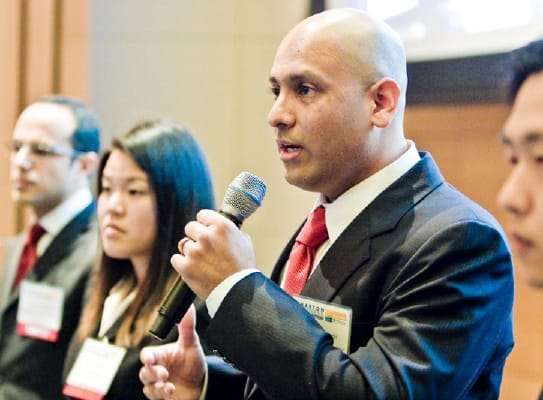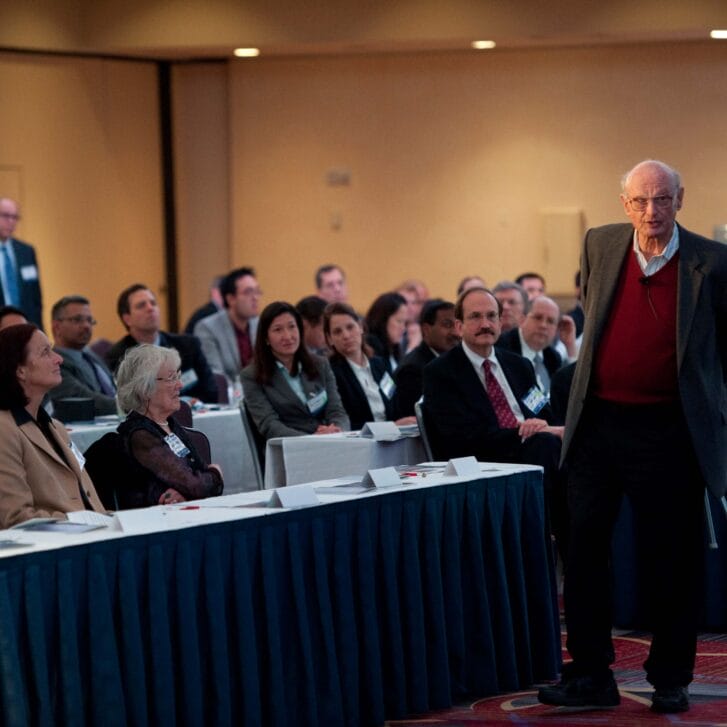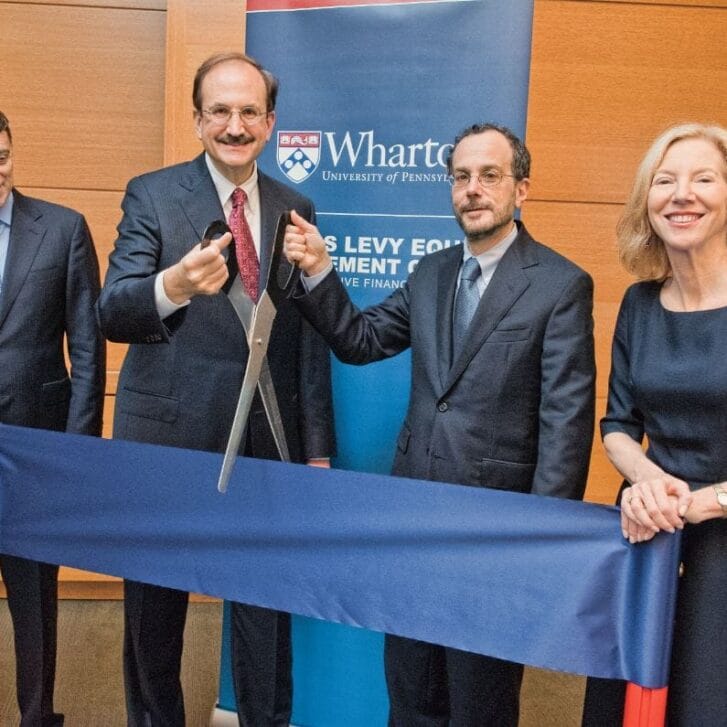In the weeks before delivering their presentations, Ben Rhee, WG’10, and his three teammates compiled a list of questions they expected the judges to ask them.
They had been working on their plan for months—researching the intricacies of reimbursement strategies and the antibiotic market and discussing their ideas at weekly meetings in the makeshift restaurant they’d discovered in the back of an Indian grocery store on Chestnut Street. But they knew that there was no way they could anticipate every question the judges would throw at them. The judges, all of whom had been recruited from the highest ranks of some of the country’s leading firms, had had plenty of time to pour over the team’s 50-page business plan, and had no doubt scoured it for mistakes and omissions. There was a high probability that, as Rhee later put it, he and his teammates would be called upon to answer at least one question they had not anticipated.
R2R Therapeutics—Resistance to Resistance—was one of eight teams that reached the finals of the Wharton Business Plan Competition this year, and Rhee, 27, was their leader. He spoke in soft, measured tones and blinked emphatically—qualities not normally associated with boardroom leadership. But, in his case, they suggested a quiet determination and seriousness that served him well. Born in Hong Kong, where his father was a self-employed trader of electronic parts, he knew from an early age what he most wanted was to be his own boss. The Wharton competition potentially represented a significant step toward that goal. At stake were $75,000 in cash and in-kind services for the three winning teams, and just as importantly, a shiny badge of prestige, all of which would go a long way toward helping the eventual winners separate potential investors from their money.
Of course, successful leadership depends not just on the leader’s abilities but also on those of the people around him. So, even before he settled on a specific business idea, Rhee enlisted as a teammate fellow Wharton student Vishwas Sheshadri, WG’10. At 34, Sheshadri was the team elder, and he projected the sort of outward confidence one might have expected to see in Rhee. If Rhee was careful and compact, Sheshadri was excited and expansive. He sang lead in a traditional Indian music group, and moved around with the upright, chest-out gait of a peacock.
Sheshadri and Rhee met last year at Wharton, but they didn’t really get to know each other until the summer, when they interned at the same pharmaceutical company in New Jersey. After work, they would hit the tennis courts (“We were both pretty bad,” Rhee admitted) and then the local Taco Bell, where Sheshadri, a vegetarian, would order the cheese quesadilla and hold forth about molecular structures. It was subject he knew a lot about: He had worked for years as a high-ranking manager at an Indian drug company, and he had a Ph.D. in microbiology and immunology.
Two other Wharton students, the auspiciously named Payman Roghani, WG’10, a physician from Iran, and Christine Chen, WG’10, a former marketing consultant from New Jersey, rounded out the group. Chen was the team’s resident expert in pricing and reimbursement as well its hype-person—the wisecracking extrovert who could be counted on to kick up the energy when it was flagging.

The morning of the competition, Rhee, Sheshadri, Chen and Roghani gathered in a classroom in Huntsman Hall, just down the hall from the auditorium where in a little over an hour they would stand and be judged. The men had on dark suits and red ties—they looked, as Chen pointed out, like a doo-wop group—and there was some discussion over whether they should wear their jackets buttoned or open (final verdict: buttoned). Occasionally, a member of another team would walk over from another part of the room and engage Rhee and his comrades in a bit of good-natured trash-talking. “Interim CEO?” said a guy named Greg, pointing to the label on Rhee’s jacket. Greg’s own label simply said CEO, and he seemed to be suggesting that Rhee’s insistence on accuracy betrayed a lack of confidence.
“We have nothing to hide,” Rhee replied.
“If you have nothing to show, you have nothing to hide,” Greg fired back. But Rhee did have something to show, and a half-hour later, he and his teammates rose and made their way to the auditorium.
A TRAGEDY AVERTED
R2R Therapeutics was one of about 150 student teams this year to enter the Wharton Business Plan Competition, which is hosted annually by Wharton Entrepreneurial Programs. Only eight teams made it to the finals. By the time they got there, they had each spent up to a year on their plans. They had found a product, researched its market potential, built a case against the competition, and drawn up financial and operational blueprints for their proposed companies, all while shouldering the weight of a full course load. Over the past few years, business plan competitions have multiplied and matured, attracting attention from a growing number of venture capitalists, and as a result, the seriousness and professionalism of the entrants have increased as well. Wharton’s competition is one of the most prestigious in the country. Sitting in the hall as the contestants paraded across the stage, you could almost forget that the Dow had fallen 213 points the day before, its biggest loss in nearly three months. If there was any hope for American businesses, chances were that some of it could be found here, in Huntsman Hall.
The product on which Rhee and his teammates had pinned their own hopes was a molecule—a pre-clinical drug that they believed to be capable of fighting the antibiotic-resistant “superbugs” that have swept through the country’s hospital wards for almost a decade, killing tens of thousands each year. Unlike other antibacterial drugs, which target proteins, DNA and RNA—materials that mutate frequently, generating drug-resistant strains—this drug attacked a molecule on the cell membrane that had not changed in millions of years and thus seemed unlikely to change in the future. Rhee had learned about it almost a year before, when he volunteered to help the Penn scientists who had invented it to apply for a grant. His belief in its potential, though, or at least his enthusiasm for finding an antibiotic that could overcome drug resistance, stemmed from an earlier “nearly tragic” experience.
In June 2008, one month before Rhee enrolled at Wharton, his wife, Lauren, woke up complaining of pain. She’d had her wisdom teeth removed the day before, but this wasn’t the kind of pain you usually get from dental surgery. “I still remember that it was Friday, June 13,” Rhee told me, with a terse, ironic laugh. “She was nauseous and she couldn’t keep anything down. That night, we were about to go to sleep—lights out—and my wife turns to me and says, ‘Ben, we’ve done so much, we’ve added all these medicines, but nothing’s helping and I don’t know what to do.’”
“My wife is a very tenacious woman,” he continued, “she’s finishing her Ph.D. in physics, and it sounded to me like she was giving up. I said, ‘Lauren, we’re going to the hospital right now,’ and once we got to the ER the head nurse saw me dragging her in and said, ‘Don’t sit down, go straight to the back.’”
“My wife was crashing. Her head and throat were swollen. The staff did a great job of getting a ventilator tube into her throat, but she was in the ICU for three weeks and had multiple surgeries. She had to learn how to walk again because her muscles had atrophied. One of the nurses in the ER told me if I’d brought her in 10 to 20 minutes later she would have been dead.”
Lauren had contracted necrotizing fasciitis, a rare “flesh-eating” disease, to use the common journalistic term. The disease gives off toxins that destroy soft tissues in the body, causing the skin and muscle to blister and decay. Unchecked, it can quickly spread into the blood, sending the body into septic shock. Many different kinds of bacteria can cause it. In Lauren’s case, a deadly strain of streptococcus was responsible, which she’d presumably picked up at the dentist’s office.
As her health improved, Rhee began thinking about “how to combat this thing,” and it was at that the point that he learned of the huge demand for “superbug” drugs. This was not the first time, however, that he’d thought about starting a biotech business. At the Pennsylvania prep school he attended, he and three friends would sit around their dorm rooms talking about their dreams of rising to the top of the biotech industry the way other kids talk about becoming rock stars. (In the late ’90s, as he pointed out to me, biotech was “pretty hot”—as it is today.) As an undergraduate at Swarthmore, he studied biology and economics, and after graduating he worked as a management consultant in the pharmaceutical industry. So Lauren’s illness didn’t set him on a new course so much as it sharpened his vision. And it provided him with a compelling narrative around which he and his team could build their case for victory.
THE PITCH

In the hallway outside the auditorium, while waiting for the cue to go on, Sheshadri cheerfully announced to his teammates that they had already won. He had decided several weeks earlier that R2R was destined for greatness, and now, with the critical moment looming, and everyone’s nerves jangling, he simply wanted to assure them that the possibility of failure had already been ruled out.
Rhee, for his part, was feeling “a little more cautious”—not quite ready to join his teammate in declaring their mission accomplished.
A student volunteer ushered the team into the auditorium, and Rhee took the microphone and greeted the judges, students, spouses and parents, who were spread out in the stadium seating above them. How do you bring an early-phase biotech product to market? That, in essence, was the question that the team had set out to answer in their plan, and while Sheshadri, Chen and Roghani stood silently, hands by their sides, expressions serious, Rhee did his best to relate what they had learned.
In short, they would first raise $2 million for in vitro tests, followed by an additional $3.5 million for animal studies. Then they’d apply for the FDA certification that would allow them to test the drug on humans. Those tests would cost another $13.5 million. If at that point the drug achieved “proof of concept,” they would attempt “to be acquired” by a major pharmaceutical company, whose scientists would complete the remaining human trials necessary for getting the drug approved. Through their research, they had determined that their drug had the potential “to be priced at parity or with a modest premium to the newest antibacterials,” and so they estimated that “big pharma” would buy them out for between $75 and $120 million.
But was that enough? Even if they hit the $120 million mark, only about half the proceeds would go back to the investors, which meant that late backers of the project could hope to triple their bets at most—not nearly enough considering the inherent risks of gambling on a drug that had yet to be tested on people. In the question-and-answer period, one of the judges asked them what they planned to do about this problem. This, as it turns out, was the inevitable question for which they had not prepared.
Days before, they had agreed that Chen, the marketing expert, would answer all questions about financial projections, and so Sheshadri, who was holding the microphone, made a move in her direction, but Rhee stopped him. “I’ll take it,” he said. Later, when asked what was running through his mind at that moment, he said, “If we don’t answer this correctly, we’re done.” It had occurred to him that he was the only person on the team with any inkling of how to do that, and as it turns out, he was right. Looking up at the judges, he explained that even after the company was sold, investors would continue to receive payments totaling up to $300 million as the product made its way through further rounds of testing. Of course, there was no guarantee that the drug would reach those “milestones,” let alone pass them, which was why Rhee had decided against mentioning them in his speech, but now was clearly not the time for caution.
As they left the stage, a professor congratulated them, specifically commending them on their decision not to use “the picture.” “The picture” was a photograph Lauren’s mother had taken of Lauren the day she arrived in the ER. It was a horrifying image—her head swollen almost to the size of basketball—and the team had wrestled with the question of whether to include it in the presentation right up until the night before. “Our friends liked the idea,” Sheshadri told me later. “However, when we ran it past our communications professors, they said it could work against you because it could attack the emotional jugular. Finally, we decided to play it safe.”
THE WINNER IS …
For an outsider, a business plan competition is a strange thing to contemplate—its logic is closed, its form cyclical. Contestants are awarded money for demonstrating that they can make money. He who proves himself most likely to win, wins.
R2R didn’t win. Or maybe they did. It depends on your perspective. They placed third, behind the runners-up from team NanoLab and the Michelson Grand Prize Winners from team Cortical Concepts. For their third-place finish, R2R received a plaque, $10,000 in in-kind services, and $5,000 in cash—more than enough money, as Chen observed, for massages in Vegas. Roghani, who had joined Sheshadri earlier in guaranteeing victory, noted that he hadn’t specified first place. And Sheshadri immediately found a way to spin the ambiguous outcome as a historical achievement. “We are the first team ever to win in the Wharton B-plan competition for a health care molecule,” he told me.
Rhee was clearly disappointed, and admitted as much over the phone a few days later. Yet the experience, he said, had been “one of, if not the highlight, of our Wharton careers. While I would say we were acquaintances before, this experience has made us very solid friends. And the learning that we gained from each other was incredible.”
It also looked like they might get an important meeting out of it.
A group of venture capitalists, he said, had expressed interest in R2R after learning about them through a competition brochure that a Wharton student had sent them. They had emailed the team a list of questions, including one that was very close to the question that had caught them by surprise at the contest. Rhee wasn’t about to email back an answer. The goal was to get in the room with them.
But if the question comes up in conversation, he’ll be prepared.
Saki Knafo is a regular contributor to the New York Times. This is his first piece for Wharton Magazine.

























